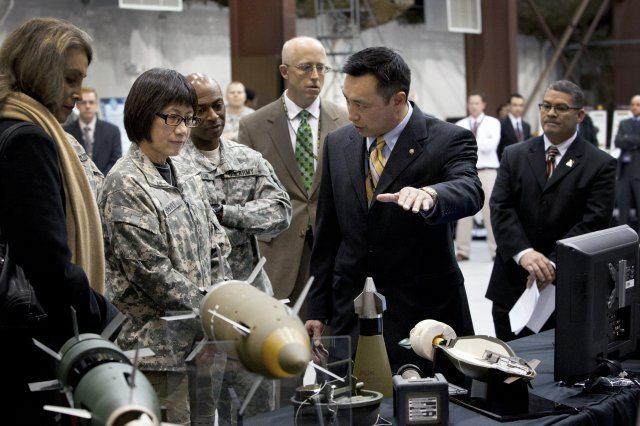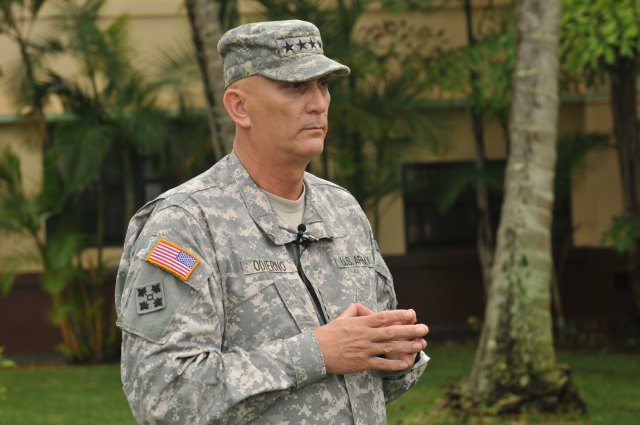From firing a new enhanced performance round to actively seeking input from mid-career managers, Heidi Shyu’s whirlwind visit Dec. 20 to Picatinny Arsenal included a town hall in which she underscored the need to streamline acquisition.
Shyu, the acting assistant secretary of the Army for Acquisition, Logistics, and Technology, or ASA(ALT), received hands-on demonstrations showcasing Picatinny’s research and development in support of mounted and dismounted warrior, fire support, air power and naval systems.
As part of her visit, Shyu fired the cased telescoped light machine gun and the new M855A1 Enhanced Performance Round from an M4 carbine.
The fielding of the round earned the Program Executive Office for Ammunition at Picatinny the prestigious David Packard Acquisition Excellence Award.
In the town hall meeting with employees, Shyu’s emphasis on affordability and efficiency came against a background in which steady increases in military spending, triggered by the 9/11 attacks on the United States, have drawn greater attention during the current economic downturn.
“What goes up, must come down. It’s unaffordable to go upward forever,” Shyu said.
“As we start to come down in our budget, one of the things we absolutely must do is be more efficient,” she continued. “Because otherwise, we buy less and less. So we’re focusing on affordability. We’re focusing on efficiency.”
Various events have heightened attention on military spending:
- •Osama bin Laden, who from his sanctuary in Afghanistan is credited with orchestrating the 9/11 attacks, was killed by Navy SEALs in neighboring Pakistan in May 2011.
- The war in Iraq, which has served as a rallying point for robust military spending, officially ended in December 2011.
- The war in Afghanistan is winding down, with the Obama administration stating that Afghanistan will be responsible for its own security by 2014.
- A severe economic downturn accompanied by high unemployment and a weak housing market has amplified discussion about government spending priorities.
As an example of the need to streamline acquisition, Shyu said major programs such as Acquisition Category I take very long to mature.
ACAT I programs are estimated to require eventual expenditure for research, development, test, and evaluation of more than $365 million (fiscal year 2000 constant dollars) or procurement of more than $2.19 billion.
“They create acquisition strategy documents that are 200-300 pages,” Shyu said.
“All we’re looking for is 20 pages. Just tell us exactly what is it you are trying to buy in terms of capabilities. What product are you trying to develop? What’s your strategy, what type of contracts? The questions we’re asking are pretty simple,” she explained. “We don’t quite understand why there are 200 to 300 pages. It’s a lot of work and it doesn’t say much. We’re trying to streamline all this.”
Shyu said ongoing discussions with the Training and Doctrine Command are intended to result in product requirements that are more realistic and achievable with incremental improvements over time.
“Requirements drive everything,” Shyu noted. “If we set the requirements way up here it forces you to develop technology that is immature as a part of the program. What happens? Technology takes longer than you thought. It costs more money than you thought.”
“The program stretches out, stretches out, and pretty soon they loose interest in your program and they kill it,” she said. “I call that the death spiral.”
With incremental improvements that are more achievable, Shyu said, “I can get things out to the warfighter a lot sooner.”
As part of ongoing efforts to balance the workforce, Shyu said core skill sets needed for Program Executive Offices are being studied.That effort is coupled with a look at the number of military, civilian and contractor personnel.
Shyu also noted that strengthening the contracting workforce is a major theme, driving increased hiring in recent years.
The Army acquisition executive also said she is working closely with Gen. Ann E. Dunwoody, commander of the Army Materiel Command, to determine if AMC has skill sets that could support the Program Executive Offices.
Shyu opened the town hall by acknowledging and congratulating Picatinny Arsenal for its many accomplishments in 2011, including winning six out of 10 Army Greatest Inventions, the Large Laboratory of the Year and the David Packard Acquisition Excellence Award.
After her visit, she sent a message to Brig. Gen. Jonathan A. Maddux, Picatinny commanding general, who hosted the visit along with ARDEC director Gerardo Melendez.
“You guys are doing great stuff,” she said. “I saw excellent collaboration across the entire materiel enterprise as well as a dedicated focus on cross-service collaboration. Your workforce is top-notch.”











